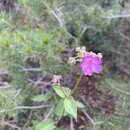Comprehensive Description
(
anglais
)
fourni par North American Flora
Allionia decipiens Standley, sp. nov
Allionia divaricata Standley, Contr. U. S. Nat. Herb. 12: 342, in part. 1909. Not A. divaricata Rydb. 1902.
Stems solitary, or few, erect or decumbent, 3-8 dm. high, slender, simple or sparsely branched below the inflorescence, green, bifariously puberulent or glabrate, the internodes elongate, usually longer than the leaves; petioles slender, 0.2-3.5 cm. long, or the uppermost
leaves sessile, the blades lanceolate to linear, 2.5—12 cm. long, 2.5-10 or rarely 20 mm. wide, obtuse to attenuate at the base, narrowed to the obtuse or acute apex, entire, bright-green, usually ciliate but otherwise glabrous; inflorescence loosely cymose-paniculate, the branches slender, alternate, viscid-villous with short fulvous hairs; involucres usually crowded, on short slender peduncles, 4-5 mm. long at anthesis, 10-12 mm. broad in fruit, densely viscidvillous, the lobes ovate-oval, rounded or obtuse at the apex; flowers 3 in each involucre, the perianth 8-10 mm. long, deep purplish-red, sparsely short-pilose, the limb 5-lobed, the lobes retuse; fruit obovoid, 4.5 mm. long, olivaceous, minutely hirtellous, the angles smooth, the sides transverse-rugose; seed oval-obovoid, 2.5 mm. long, pale yellowish-brown.
Type collected in an oak thicket, Brazos Canyon, Rio Arriba County, New Mexico, August 24, 1914, P. C. Standley & H. C. Bollman 10743 (U. S. Nat. Herb. no. 689453).
Distribution: Mountain slopes, Arizona, New Mexico, and southern Colorado.
- citation bibliographique
- Paul Carpenter Standley. 1918. (CHENOPODIALES); ALLIONIACEAE. North American flora. vol 21(3). New York Botanical Garden, New York, NY
Comprehensive Description
(
anglais
)
fourni par North American Flora
Allionia decipiens Standley, sp. nov
Allionia divaricata Standley, Contr. U. S. Nat. Herb. 12: 342, in part. 1909. Not A. divaricata Rydb. 1902.
Stems solitary or few, erect or decumbent, 3-8 dm. high, slender, simple or sparsely branched below the inflorescence, green, bifariously puberulent or glabrate, the internodes elongate, usually longer than the leaves; petioles slender, 0.2-3.5 cm. long, or the uppermost leaves sessile, the blades lanceolate to linear, 2.5-12 cm. long, 2.5-10 or rarely 20 mm. wide, obtuse to attenuate at the base, narrowed to the obtuse or acute apex, entire, bright-green, usually ciliate but otherwise glabrous; inflorescence loosely cymose-paniculate, the branches slender, alternate, viscid-villous with short fulvous hairs; involucres usually crowded, on short slender peduncles, 4-5 mm. long at anthesis, 10-12 mm. broad in fruit, densely viscidvillous, the lobes ovate-oval, rounded or obtuse at the apex; flowers 3 in each involucre, the perianth 8-10 mm. long, deep purplish-red, sparsely short-pilose, the limb 5-lobed, the lobes retuse; fruit obovoid, 4.5 mm. long, olivaceous, minutely hirtellous, the angles smooth, the sides transverse-rugose; seed oval-obovoid, 2.5 mm. long, pale yellowish-brown.
Type collected in an oak thicket, Brazos Canyon, Rio Arriba County, New Mexico, August 24, 1914, P. C. Standley &* H. C. Bollman 10743 (U. S. Nat. Herb. no. 689453).
Distribution: Mountain slopes, Arizona, New Mexico, and southern Colorado.
- citation bibliographique
- Paul Carpenter Standley. 1918. (CHENOPODIALES); ALLIONIACEAE. North American flora. vol 21(3). New York Botanical Garden, New York, NY

